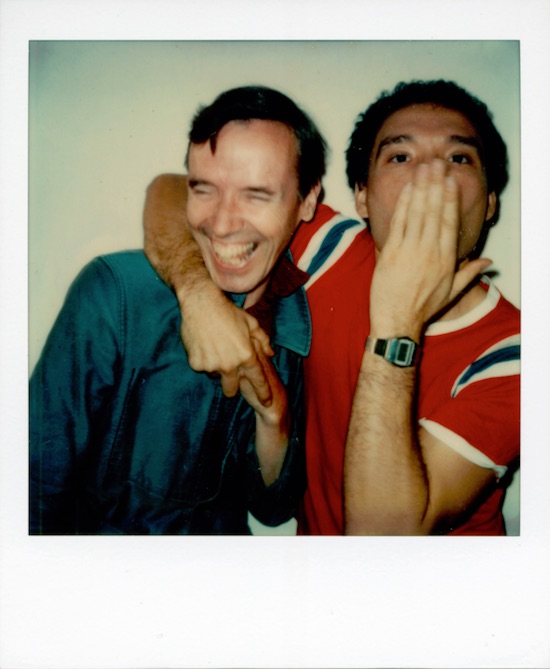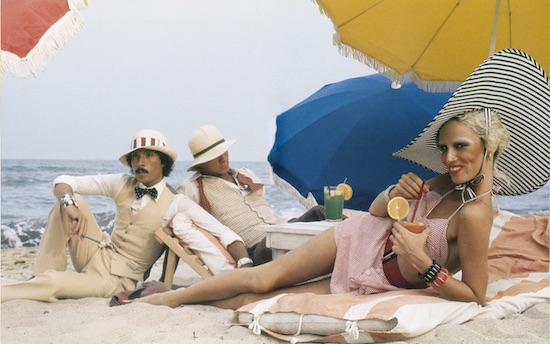There’s a strong chance you’ve never heard of fashion illustrator Antonio Lopez or his long time collaborator Juan Ramos. But you have been influenced by them. In fact, if you live in East London, sport a moustache, and wear a nice natty suit, then you’re basically already modelling yourself on him. Yes him, not Andy Warhol or any of the other big names you can identify from New York in the 1970s. Whilst the stories of his contemporaries have been bandied about in the decades that have passed, Antonio and Juan’s story seemingly died with the Aids-related illnesses that killed them.
When director James Crump first asked for access to their archive over twenty years ago, he was told he was the first person to ask. “I was just drawn to the story by way of the photographs, the Instamatics. I got into the drawings too, but initially it was just this incredible archive of Instamatic photographs that I would spend hours looking at. And I was just struck that these people were having such a fun and sexy time and I felt like I had been born so late – not so late but too late – because I was around in the 70s but I was just a young person, a young kid. And I just felt, like ‘Wow! I missed out on this incredible moment to just indulge this really interesting, sexy time.’”
It’s hard not to be seduced by the 1970s, and with Brexit taking the UK back to 1976 and hit shows like HBO’s The Deuce currently shooting a second series, it seems that the 1970s is where it’s at. “It’s really a special band of time, you know, 1969–1973, where everything seemed possible. There was some sort of attainability and there was this new freedom that was bought about by all the battles that were won in the late 60s, you know, battles for civil rights and for gay rights, for feminism and fighting against the Vietnam War. So the early 70s was this moment where there was a kind of Utopian energy and spirit,” says Crump.
Where HBO’s The Deuce is exploring capitalism in its many forms by way of a street no one outside of New York had ever heard of, Crump’s film immerses the viewer in the early neoliberal era of collaboration and hope. Whilst there was seemingly a mild rivalry between the Warhol camp and the Lopez camp, ultimately it was a time when artists, musicians, dancers, models, designers, and poets worked together, says Crump,
“I mean, I think that today, in this moment we’re in now, people work in silos. They’ll work independently of each other and they’re competitive. I mean, high capitalism – late capitalism – and the hyper-commoditised art world have bought this about. And so, you know, people are so territorial and not as generous and driven more by narcissistic urges. Not to say that Antonio is not a narcissist – I mean, he sort of foretells the Instagram generation in a way. But I think that’s what also drew me to his story, because I live in New York City and I’ve lived in New York for a long time and I love the history of New York, especially Lower Manhattan, and the history of the art scenes that have happened there. And in that moment there was a mingling of writers and poets and filmmakers and dancers and illustrators and visual artists, architects, and creatives of all walks of life. Whereas, today, you don’t have that kind of collaborative exchange so much. It happens, [but] it doesn’t happen very often.”
This is what underpinned Crump’s desire to unpick Antonio’s story, tangled as it is with the great figures of the time, mainly because everyone worked with, or had sex with, everyone else. And perhaps it was by having artists working together rather than against each other that meant they were able to push boundaries. Lopez and Ramos’s illustrations didn’t just make fashion illustration edgier, by introducing the clothes to women in a way that they could relate to them, and paving the way for the imagery of the fashion photography we know today, but they pushed for diversity in a way that makes the paltry inroads we’ve gone on to make even more pathetic than they already appear.

Lopez and Ramos were interested in using models that reflected the New York they saw around them. And when they insisted on using black models at a time when conservative American publications like Vogue wouldn’t let them, they moved to Europe – more specifically, to Paris – where they had far more creative freedom.
Imagine a fashion photographer today doing that, imagine if someone like David Bailey, or Steven Meisel not only insisted on using black models, or models who look like they actually eat, but moved continents to do it? If Aids hadn’t stolen them both, perhaps we wouldn’t still be counting how many black models have graced the British or American Vogue covers on one hand.
“What I wanted to do from the very outset of this project,” says Crump, “was to create a time capsule in which the viewer would kind of be immersed in this period and be transported to 1970 and Antonio’s story. It’s about him ostensibly, but also I really wanted to make this visceral immersive film about the period.” In doing so he’s made a film that not only transports you back, but also provokes questions, as the best kind of art does. I wondered where we lost this collaborative spirit and energy.
The sudden full stop of Antonio’s life as Aids came and stopped him in his tracks seemed to foretell the end of the work together and play together spirit of the 1970s. The 80s that followed bought with it fear, stigma, and the reversal of our sexual freedom. Maybe we’ve been so focused on the individual lives that Aids took from us in the 80s that it’s been too hard to see that we didn’t just lose people; we lost movements, we lost freedom, as the disease came and scared everyone back indoors to the quiet safety of a solo studio.
Describing a moment towards the end of the film when Bill Cunningham breaks down talking about Antonio’s death, Crump reflects, “Bill Cunningham who is, as we consider him, a kind of de facto narrator, he kind of speaks for a generation of loss when he talks about Antonio dying. And when he’s crying in the film, about a particular event [Lopez’s death], it’s also something more than that. He’s kind of a biographer of a generation, a narrator of a generation.”
This is really what the whole film is about. Except it’s more than just telling you the story of the era through one man’s life. It really does transport you back. I don’t mind telling you that I found myself preening in front of every reflective surface I passed in the days after I watched it. Everything – including myself – felt a bit sexier in that 1970s bubble.
But there’s a lot to discover in this film, not just sex or fashion. Familiar faces are seen from new perspectives. Most notable, for me, was Jerry Hall, who I had assumed, by going from Mick Jagger to Rupert Murdoch, was displaying a decsent of man that was out of character. But once you see her on the arm of Antonio Lopez, Jagger himself starts to look like a sloppy second best. I speak for myself here, not Jerry, who doesn’t talk about any of it, such is the life of a newspaper mogul’s wife (remember when Jerry Hall used to talk and do interviews?).
This is the thing about Lopez: he is one of those achingly cool, and beautiful, people who just have that ‘something’ you can never quite put your finger on. And that’s before we even get to his talent. If Lopez were alive today, every hipster in East London would follow him around town until they had worn down their loafers, or the skin around their bare ankles – whichever happens first. Even the way he and Ramos worked, Lopez drawing whilst Ramos directed, is intimate and sexy. Imagine Terry Richardson taking directions in his studio, “put her top back on Terry, it’s the clothes we’re selling” his long-suffering collaborator would shout.
By the end of the film its easy to see why all the kool kids of the 1970s not only knew who Lopez was, but were in love with him. It’s less easy to see why it’s taken so long for someone to bring his story to a more mainstream audience. But that is changing. James Crump’s film is the beginning. There are exhibitions being planned and that archive is finally starting to find the audience it deserves.
The new Instagram generation is sure to latch onto his style and his illustrations, but it’s the rediscovery of that 1970s spirit of collaboration, of everyone’s in it together, that I hope today’s audience latch onto. But hey, let’s not talk politics; let’s talk sex, fashion, and disco.
Antontio Lopez 1970 is in cinemas and on demand services now


